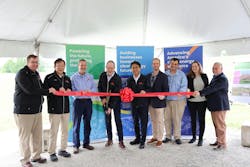Onyx, Sol Deliver 5.7-MW Solar to Energize Toyota Boshoku Automotive Interiors Plant in Illinois
A key U.S. automotive components supplier for Toyota sports utility vehicles is embracing near-site distributed energy with a new 5.7-MW solar project next door to its Illinois manufacturing plant.
Toyota Boshoku America (TBA) worked with Onyx Renewables to create the ground-mounted solar array on 17 acres adjacent to TBA’s manufacturing facility in Lawrenceville, Illinois. The manufacturing facility creates automotive interiors, particularly doors and seat assembly components, for the Toyota Highlander and Sequoia models.
The newly completed solar array is expected to fulfil 85% of electricity needs of the TBA Lawrenceville plant. Onyx Renewables is owner and operator of the solar farm, while Sol Systems and Nelnet Renewable Energy also participated in the collaborative effort.
"This is the kind of collaborative clean energy development that drives real progress and public support," said Patty Rollin, Chief Commercial Officer at Onyx Renewables, in a statement. "Together with our partners, we are thrilled to deliver a project that reduces emissions, lowers energy costs, and sets a high standard for workforce development."
Nelnet Renewable Energy handled engineering, procurement and construction contractor duties on the Toyota Boshoku distributed energy project. The solar array could generate up to 9.5 million kWh of electricity in its first year, project developers say.
"This project reflects our commitment to reducing our carbon footprint and our dedication to supporting the communities where we operate. It is also a significant step towards our goal of achieving net-zero carbon emissions by 2050," said Ryan Hunt, vice president of TBA. "We're proud to partner with companies like Onyx, Sol Systems, and Nelnet to bring clean, reliable energy to Lawrenceville."
Sol Systems originated and mobilized the on-site power project. Sol also will plant a pollinator-friendly habitat around the solar system.
Onyx worked with the Illinois Department of Natural Resources on choosing the types of plants and seeds for the habitat.
Toyota Boshoku America is hardly the first automobile industry firm to embrace on-site power. Sprocket Power completed microgrids at five New York dealerships with Honda, Toyota and GMC affiliations.
TBA employs more than 14,000 people in 23 manufacturing locations around the U.S.
The Global Battery Storage Race is On
Read more with this free EnergyTech E-Book
About the Author
Rod Walton, EnergyTech Managing Editor
Managing Editor
For EnergyTech editorial inquiries, please contact Managing Editor Rod Walton at [email protected].
Rod Walton has spent 17 years covering the energy industry as a newspaper and trade journalist. He formerly was energy writer and business editor at the Tulsa World. Later, he spent six years covering the electricity power sector for Pennwell and Clarion Events. He joined Endeavor and EnergyTech in November 2021.
Walton earned his Bachelors degree in journalism from the University of Oklahoma. His career stops include the Moore American, Bartlesville Examiner-Enterprise, Wagoner Tribune and Tulsa World.
EnergyTech is focused on the mission critical and large-scale energy users and their sustainability and resiliency goals. These include the commercial and industrial sectors, as well as the military, universities, data centers and microgrids. The C&I sectors together account for close to 30 percent of greenhouse gas emissions in the U.S.
He was named Managing Editor for Microgrid Knowledge and EnergyTech starting July 1, 2023
Many large-scale energy users such as Fortune 500 companies, and mission-critical users such as military bases, universities, healthcare facilities, public safety and data centers, shifting their energy priorities to reach net-zero carbon goals within the coming decades. These include plans for renewable energy power purchase agreements, but also on-site resiliency projects such as microgrids, combined heat and power, rooftop solar, energy storage, digitalization and building efficiency upgrades.


